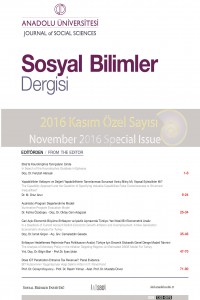Araştırma Makalesi
Yıl 2016,
Cilt: 16 Sayı: Özel Sayı, 161 - 178, 15.11.2016
Öz
Tedarik zinciri son kullanıcının ihtiyaçlarını karşılamak amacına yönelik olarak pek çok üyeden oluşan karmaşık bir yapıdır. Bu zincirde yer alan üyeler arttıkça bilgi bozulması yaşanmakta ve literatürde kamçı veya kırbaç etkisi olarak açıklanan stok dalgalanmaları ortaya çıkmaktadır. Bu çalışmanın amacı, tedarik zincirinin Stella 9.1.4. simülasyon programı kullanılarak modellenmesi ve kamçı etkisine yol açan faktörlerin bu model içerisinde analiz edilmesidir.
Anahtar Kelimeler
Kaynakça
- Ali, M. M. Babai, M. Z. Boylan, J. E. Syntetos, A. A. (2015). On The Use ff Simple Moving Averages For Supply Chains Where Information is not Shared. IFAC-Papers OnLine, 48-3, 1756–1761.
- Babai, M.Z. Boylan, J.E. Syntetos, A.A., Ali, M.M. (2015). Reduction of The Value of Information Sharing As Demand Becomes Strongly Autocorrelated. International Journal of Production Economics, http://dx.doi.org/10.1016/j.ijpe.2015.05.005 (baskıda makale).
- Blos, M. F. Da Silva, R. M. Miyagi, P. E. (2015). Application of An Agent-Based Supply Chain To Mitigate Supply Chain Disruptions. IFAC-Papers OnLine, 48-3, 640–645.
- Cannella, S. Framinan, J. M. Bruccoleri, M. Barbosa-Póvoa, A. P., Relvas, S. (2015). The Effect of Inventory Record Inaccuracy in Information Exchange Supply Chains. European Journal of Operational Research, 243, 120–129.
- Costantino, F. Gravio, G.D. Shaban, A., Tronci, M. (2015a). The Impact of Information Sharing on Ordering Policies To Improve Supply Chain Performances. Computers & Industrial Engineering, 82, 127–142.
- Costantino, F. Gravio, G.D. Shaban, A., Tronci, M. (2015b). A Real-Time SPC Inventory Replenishment System To Improve Supply Chain Performances. Expert Systems with Applications, 42, 1665–1683.
- Costantino, F. Gravio, G.D. Shaban, A., Tronci, M. (2015c). SPC Forecasting System To Mitigate The Bullwhip Effect and Inventory Variance in Supply Chains. Expert Systems with Applications, 42, 1773–1787.
- Costas, J. Ponte, B. Fuente, D.d.l. Pino, R., Puche, J. (2015). Applying Goldratt’s Theory of Constraints To Reduce The Bullwhip Effect Through Agent-Based Modeling. Expert Systems with Applications, 42, 2049–2060.
- Dominguez, R. Cannella, S., Framinan, Jose M. (2015a). The Impact of The Supply Chain Structure on Bullwhip Effect. Applied Mathematical Modelling, (baskıda makale).
- Dominguez, R. Cannella, S., Framinan, Jose M. (2015b). On Returns and Network Configuration in Supply Chain Dynamics. Transportation Research Part E, 73, 152–167.
- Duan, Y. Yao, Y., Huo, J. (2015). Bullwhip Effect Under Substitute Products. Journal of Operations Management, 36, 75–89.
- Editorial. (2015). System Dynamics Perspectives and Modeling Opportunities For Research in Operations Management. Journal of Operations Management, (baskıda makale).
- Fu, D. Ionescu, C. Aghezzaf, E-H., Keyser, R. D. (2015). Quantifying and Mitigating The Bullwhip Effect in A Benchmark Supply Chain System by An Extended Prediction Self-Adaptive Control Ordering Policy. Computers & Industrial Engineering, 81, 46–57.
- Göksu, A. Kocamaz, U. E. Uyaroğlu, Y. (2015). Synchronization and Control of Chaos in Supply Chain Management. Computers & Industrial Engineering, 86, 107–115.
- Hosoda, T. Disney, S. M., Gavirneni, N. (2015). The Impact of Information Sharing, Random Yield, Correlation, and Lead Times in Closed Loop Supply Chains. European Journal of Operational Research, doi: 10.1016/j.ejor.2015.05.036. (baskıda makale). http://www.beergame.org , 27.05. 2015
- Jeng, D. J-F. (2015). Generating A Causal Model of Supply Chain Collaboration Using The Fuzzy DEMATEL Technique. Computers & Industrial Engineering, 87, 283–295.
- Lee, J. Cho, H., Kim, Y. S. (2015). Assessing Business Impacts of Agility Criterion and Order Allocation Strategy in Multi-Criteria Supplier Selection. Expert Systems with Applications, 42, 1136–1148.
- Ma, Y. Wang, N. He, Z. Lu, J., Liang, H. (2015). Analysis of The Bullwhip Effect in Two Parallel Supply Chains with Interacting Price-Sensitive Demands. European Journal of Operational Research, 243, 815–825.
- Mackelprang, A. W., Malhotra, M. K. (2015). The Impact of Bullwhip on Supply Chains: Performance Pathways, Control Mechanisms, and Managerial Levers. Journal of Operations Management, 36, 15–32.
- Mangan, J. Lalwani, C., Butcher, T. (2008). Global Logistics And Supply Chain Management, New Jersey: John Wiley & Sons Ltd.
- Masten, K. A. Kim, S-L. (2015). So Many Mechanisms, So Little Action: The Case For 3rd Party Supply Chain Coordination. International Journal of Production Economics, 168, 13–20.
- Murray, P. W. Agard, B. Barajas, M. A. (2015). Forecasting Supply Chain Demand By Clustering Customers. IFAC-PapersOnLine, 48-3, 1834–1839.
- Nagaraja, C. H. Thavaneswaran, A., Appadoo, S. S. (2015). Measuring The Bullwhip Effect for Supply Chains with Seasonal Demand Components. European Journal of Operational Research, 242, 445–454.
- Qiu, X. Yu, L., Zhang, D. (2015). Stabilization of Supply Networks with Transportation Delay and Switching Topology. Neurocomputing, 155, 247–252.
- Sterman, J. D. Doğan, G. (2015). “I’m not hoarding, I’m just stocking up before the hoarders get here.” Behavioral causes of phantom ordering in supply chains. Journal of Operations Management, (baskıda makale).
- Udenio, M. Fransoo, J. C., Peels, R. (2015). Destocking, The Bullwhip Effect, and The Credit Crisis: Empirical Modeling of Supply Chain Dynamics. International Journal of Production Economics, 160, 34–46.
- Wang, Z. Wang, X., Ouyang, Y. (2015). Bounded Growth of The Bull-Whip Effect Under A Class of Nonlinear Ordering Policies. European Journal of Operational Research, doi: 10.1016/j. ejor.2015.04.047 (baskıda makale).
- Xu, K. Dong, Y. Xia, Y. (2015). ‘Too Little’ or ‘Too Late’: The Timing of Supply Chain Demand Collaboration. European Journal of Operational Research, 241, 370–380.
- Zhao, Y., Zhao, X. (2015). On Human Decision Behavior in Multi-Echelon Inventory Management. International Journal of Production Economics, 161, 116–128.
Toplam 29 adet kaynakça vardır.
Ayrıntılar
| Birincil Dil | Türkçe |
|---|---|
| Bölüm | Araştırma Makalesi |
| Yazarlar | |
| Yayımlanma Tarihi | 15 Kasım 2016 |
| Gönderilme Tarihi | 27 Mayıs 2015 |
| Yayımlandığı Sayı | Yıl 2016 Cilt: 16 Sayı: Özel Sayı |
Cited By
Gıda Tedarik Zincirinde Kamçı Etkisi Yaratan Kriterlerin Best-Worst Metodu ile Değerlendirilmesi
Erzurum Teknik Universitesi Sosyal Bilimler Enstitusu Dergisi
https://doi.org/10.29157/etusbed.1559544
Bu eser Creative Commons Atıf-GayriTicari 4.0 Uluslararası Lisansı ile lisanslanmıştır.

